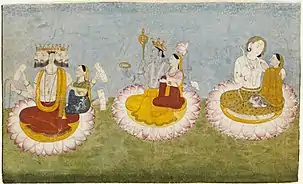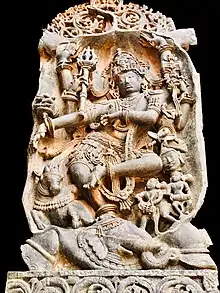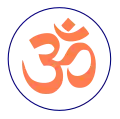Hindu mythology
Hindu mythology is the body of myths attributed to, and espoused by, the adherents of the Hindu religion, found in Sanskrit texts such as the Vedic literature,[1] epics like Mahabharata and Ramayana,[2] the Puranas,[3] and mythological stories specific to a particular ethnolinguistic group like the Tamil Periya Puranam and Divya Prabandham, and the Mangal Kavya of Bengal. Hindu myths are also found in widely translated popular texts such as the fables of the Panchatantra and the Hitopadesha, as well as in Southeast Asian texts.[4][5]
| Part of a series on |
| Hinduism |
|---|
 |
| Part of a series on |
| Hindu mythology |
|---|
 |
| Sources |
| Cosmology |
| Deities |
| Personalities of the Epics |
| Hinduism Portal |
| Mythology |
|---|
Primary sources
- Vedas
- Itihasa
- Major Puranas
- Bengali literature
- Tamil literature
Origins and development
Indus Valley Civilisation
According to Joseph Campbell, the Indus Valley (2600–1900 BCE) may have left traces in the beliefs and traditions of Hinduism. Artefacts have revealed motifs that are also employed and revered by Hindus today, such as primary male deities worshipped by a ruling elite, mother goddesses, nature spirits, snake worship, as well as the reverence of other theriomorphic (animal-shaped) beings.[6] These themes would be maintained by the Dravidian folk religion even after the decline of its parent civilisation around 1800 BCE.[7]
Vedic Period
A major factor in the development of Hinduism was the Vedic religion. The Indo-Aryan migration brought their distinct beliefs to the Indian subcontinent, where the Vedas were composed around 1500 BCE. The Indo-Aryans Vedic pantheon of deities included the chief god Indra, the sun deity Surya, Ushas, as well as Agni.[8][9]
Brahmanical Period
This period saw the composition of commentaries referred to as the Brahmanas.[10]
Upanishad Period
According to Williams, from 900–600 BCE, the protests of the populace against sacrifices made towards the Vedic gods and rebellions against the Brahmin class led to the embrace of reform by the latter and the composition of the fourth Veda and the Vedanta texts. About half of the Upanishads were mystical and unitive, speaking of experiencing the divine as the one (ekam), while the other half promoted devotion to one or more deities. New gods and goddesses were celebrated, and devotional practices began to be introduced.[11]
Sramanic movements
Elements such as those emerging from Buddhism and Jainism made their “heteroprax” contributions to later Hindu mythology, such as temples, indoor shrines, and rituals modeled after service to a divine king. Renunciate traditions contributed elements that questioned sacrifices and the killing of animals, and promoted asceticism and vegetarianism. All of these themes would be incorporated by the Brahmin classes into the later Hindu synthesis, which developed in response to the sramanic movements between ca. 500–300 BCE and 500 CE, and also found their way into Hindu mythology.[11]
Epic Period
The era from 400 BCE to 400 CE was the period of the compilation of India’s great epics, the Mahabharata and Ramayana. These were central manifestations of the newly developing Hindu synthesis, contributing to a specific Hindu mythology, emphasising divine action on earth in Vishnu's incarnations and other divine manifestations. The lore of the devas and the asuras expanded. Epic mythology foreshadowed the rich polytheism of the next two periods. The Mahabharata contained two appendices that were extremely important sources for later mythological development, the Bhagavad Gîta and the Harivamsa.
Puranic Period
According to Williams, the mythology of the Puranas can be broken into three periods (300–500; 500–1000; 1000–1800), or the whole period may simply be referred to as the Hindu middle ages. This age saw the composition of the major Puranic texts of the faith, along with the rise of sectarianism, with followers amassing around the cults of Vishnu, Shiva, or Devi. The three denominations within this period help locate in time historical developments within the sectarian communities, the rise and decline of Tantrism and its influence on mainstream mythology, the tendencies in Puranic mythologising of subordinating Vedic gods and past heroes to ever-increasing moral weaknesses, going on to be identified as a period of exuberant polytheism. However, this was also accompanied with the belief in monotheism, the idea that all paths lead to the Ultimate Reality, Brahman.[11]
Tantric Period
According to Williams, during the Tantric period from 900–1600 CE, the mythology of Tantra and Shaktism revived and enriched blood sacrifice and the pursuit of pleasure as central themes. Tantra’s stories differed radically in meaning from those of epic mythology, which favored devotion, asceticism, and duty. There was either a revival or emphasis that was placed on the shakti or the cosmic energy of goddesses, a concept that had emerged during the Indus Valley Civilisation.[11]
Modern Period
In the contemporary era, the mythologies of the dominant traditions of Vaishnavism, Shaivism, and Shaktism prevail.[12] Several myths were found or invented to make tribals or former "outcastes" Hindus and bring them within the cultural whole of a reconstructed Hindu mythological community.
Mythical themes and types

Academic studies of mythology often define mythology as deeply valued stories that explain a society's existence and world order: those narratives of a society's creation, the society's origins and foundations, their god(s), their original heroes, mankind's connection to the "divine", and their narratives of eschatology (what happens in the "after-life"). This is a very general outline of some of the basic sacred stories with those themes. In its broadest academic sense, the word myth simply means a traditional story. However, many scholars restrict the term "myth" to sacred stories.[13] Folklorists often go further, defining myths as "tales believed as true, usually sacred, set in the distant past or other worlds or parts of the world, and with extra-human, inhuman, or heroic characters".[14]
In classical Greek, muthos, from which the English word myth derives, meant "story, narrative." Hindu mythology does not often have a consistent, monolithic structure. The same myth typically appears in various versions, and can be represented differently across different regional and socio-religious traditions.[15] Many of these legends evolve across these texts, where the character names change or the story is embellished with greater details.[15][16] According to Suthren Hirst, these myths have been given a complex range of interpretations.[15] While according to Doniger O'Flaherty, the central message and moral values remain the same.[16] They have been modified by various philosophical schools over time, and are taken to have deeper, often symbolic, meaning.[15]
Cosmology
- Brahman The Ultimate Reality in Hinduism
- Satyaloka The abode of Brahma
- Hiranyagarbha The golden egg from which creation emerges
- Vaikuntha The abode of Vishnu
- Goloka The abode of Radha Krishna
- Kailasa The abode of Shiva
- Bhumi The Hindu name for Earth.
- Patala The netherworld
- Svarga The Hindu concept of "heaven", but not strictly related to afterlife, but more like "utopia" in real world.
- Naraka The Hindu concept of "hell", but not a site of permanent damnation
Deities
Brahman The Ultimate Reality
Vaishnavism (Vishnu-centric)
Vishnu The God of Preservation
Lakshmi The Goddess of Prosperity
Dashavatara Ten incarnations of Vishnu, chiefly Krishna and Rama
Shaivism (Shiva-centric)
Shiva The God of Destruction
Parvati The Goddess of Power
Ganesha The God of Auspiciousness
Kartikeya The God of Victory and War
Shaktism (Goddess-centric)
Mahadevi Supreme Goddess
Saraswati Goddess of Wisdom
Lakshmi Goddess of Prosperity
Parvati Goddess of Power
Henotheism and Polytheism
- Brahma The God of Creation
- Vishnu The God of Preservation
- Shiva The God of Destruction
- Indra The King of the Devas and Svarga
- Saraswati The Goddess of Wisdom
- Lakshmi The Goddess of Prosperity
- Parvati The Goddess of Power
- Ganesha The God of Auspiciousness
- Krishna The God of love and protection
- Radha The goddess of love, chief consort of Krishna
- Rukmini The first queen consort and principal wife of Krishna[17]
- Satyabhama The third queen consort of Krishna
- Bhudevi Goddess Earth
- Kartikeya (Murugan) God of Victory and War
- Rama The seventh incarnation of Vishnu
- Kali A terrible aspect of Parvati
- Durga An incarnation of Parvati
- Ashvins Twin gods of medicine
- Agni God of Fire
- Rudra God of the storm
- Shakti Personification of power
- Vayu God of the wind
- Surya God of the Sun
- Varuna God of the oceans
- Lakshmana Younger Brother of Rama
- Hanuman Highest devotee of Rama
- Sita Consort of Rama and incarnation of Lakshmi
- Sati An incarnation of the goddess Shakti
- Kubera God of Wealth
- Parshurama The sixth incarnation of Vishnu
- Yama God of Death and the Underworld
- Chandra God Moon
- Balarama incarnation of Shesha Naag
- Prajapati Creator deity
- Kalki Prophesied final incarnation of Vishnu
- Dashavatara (Ten Incarnations of Vishnu)
- Narada Divine sage, messenger of gods
- Sundaravalli Daughter of Vishnu, consort of Murugan
- Devasena Daughter of Vishnu, consort of Murugan
- Kamadeva The God of love and desire
- Rati The Goddess of love and desire
Dravidian folk religion (Indigenous Dravidian faith)
See also
Citations
- Macdonell 1978, p. 1–9.
- Washburn Hopkins 1986, pp. 1–3.
- Bonnefoy 1993, p. 90–101.
- Olivelle 1999, p. xii–xiii.
- Waldau & Patton 2009, p. 186, 680.
- Opler, Morris E.; Campbell, Joseph (January 1962). "The Masks of God: Primitive Mythology". The Journal of American Folklore. 75 (295): 82. doi:10.2307/537862. ISSN 0021-8715. JSTOR 537862.
- "Decline of the Indus River Valley Civilization (c. 3300–1300 BCE)". Climate in Arts and History. Archived from the original on 31 July 2022. Retrieved 31 July 2022.
- Williams 2003, pp. 6–7.
- Macdonell, Arthur Anthony (1974). Vedic mythology (Reprint, 1995 ed.). Delhi: Motilal Banarsidass. ISBN 0-8426-0674-2. OCLC 1951729.
- Williams 2003, p. 7.
- Handbook of Hindu mythology. 1 May 2004. p. 10.
- Bishara, Azmi (1 August 2021), "Ibn Khaldun's 'Asabiyya and Sects", Sectarianism without Sects, Oxford University Press, pp. 199–220, doi:10.1093/oso/9780197602744.003.0007, ISBN 978-0-19-760274-4
- "What is a Myth?". Archived from the original on 7 August 2007. Retrieved 17 June 2007.
- "Defining myth". Archived from the original on 7 August 2007. Retrieved 17 June 2007.
- Suthren Hirst 1998.
- Doniger O'Flaherty 1975, p. 11, 21–22.
- Vemsani, Lavanya (13 June 2016). Krishna in History, Thought, and Culture: An Encyclopedia of the Hindu Lord of Many Names: An Encyclopedia of the Hindu Lord of Many Names. ABC-CLIO. p. 91. ISBN 978-1-61069-211-3. Archived from the original on 26 March 2023. Retrieved 2 March 2023.
General sources
- Bonnefoy, Yves (1993). Asian Mythologies. University of Chicago Press. ISBN 978-0-226-06456-7. Archived from the original on 24 April 2023. Retrieved 28 December 2017.
- Doniger O'Flaherty, Wendy (1975), Hindu epics: A Sourcebook translated from the Sanskrit, Penguin, ISBN 978-0140449907
- Washburn Hopkins, Edward (1986). Epic Mythology. Motilal Banarsidass. ISBN 978-81-208-0227-8. Archived from the original on 24 April 2023. Retrieved 28 December 2017.
- Macdonell, Arthur Anthony (1978). Vedic Mythology ((reprint) ed.). Motilal Banarsidass. ISBN 978-81-208-1113-3. Archived from the original on 24 April 2023. Retrieved 28 December 2017.
- Olivelle, Patrick (1999). Pañcatantra: The Book of India's Folk Wisdom. Oxford University Press. ISBN 978-0-19-283988-6.
- Suthren Hirst, Jacqueline (1998), "Myth and history", in Bowen, Paul (ed.), Themes and Issues in Hinduism, Cassell
- Waldau, Paul; Patton, Kimberley (2009). A Communion of Subjects: Animals in Religion, Science, and Ethics. Columbia University Press. ISBN 978-0-231-13643-3.
- Williams, George M. (2003). Handbook of Hindu Mythology. New York: Oxford University Press. ISBN 978-0-19-533261-2.
Further reading
- Bhairav, J Furcifer; Rakesh Khanna (2020). Ghosts, Monsters, and Demons of India. Blaft Publications Private Limited. ISBN 9789380636467. OCLC 1259298225.
- Brockington, J. L. (1998). The Sanskrit Epics. BRILL Academic. ISBN 90-04-10260-4.
- Buitenen, J. A. B. van; Dimmitt, Cornelia (1978). Classical Hindu Mythology: A Reader in the Sanskrit Puranas. Philadelphia: Temple University Press. ISBN 0-87722-122-7.
- Campbell, Joseph (2003). Myths of Light: Eastern Metaphors of the Eternal. Novato, Calif.: New World Library. ISBN 1-57731-403-4.
- Dalal, Roshen (2010). Hinduism: An Alphabetical Guide. Penguin Books India. ISBN 978-0-14-341421-6.
- Dallapiccola, Anna L. (2002). Dictionary of Hindu Lore and Legend. ISBN 0-500-51088-1.
- Dimitrova, Stefania (2017). The Day of Brahma: The Myths of India—Epics of Human Destiny. Alpha-Omega. ISBN 978-954-9694-27-7.
- Dowson, John (1888). A Classical Dictionary of Hindu Mythology and Religion, Geography, History, and Literature. London: Trubner & Co.
- Krishna, Nanditha (2009). The Book of Vishnu. Penguin Books India. ISBN 978-0-14-306762-7.
- Krishna, Nanditha (2010). Sacred Animals of India. Penguin Books India. ISBN 978-0-14-306619-4.
- Macdonell, Arthur Anthony (1995). Vedic Mythology. Delhi: Motilal Banarsidass. ISBN 81-208-1113-5.
- Pattanaik, Devdutt (2003). Indian Mythology: Tales, Symbols, and Rituals from the Heart of the Subcontinent. Inner Traditions/Bear & Company. ISBN 0-89281-870-0.
- Rao, T. A. Gopinatha (1914). Elements of Hindu Iconography. Vol. 1: Part I. Madras: Law Printing House.
- Walker, Benjamin (1968). Hindu World: An Encyclopedic Survey of Hinduism. London: Allen & Unwin.
- Wilkins, W. J. (1882). Hindu Mythology, Vedic and Purānic. Thacker, Spink & Co.
External links
- Clay Sanskrit Library publishes classical Indian literature, including the Mahabharata and Ramayana, with facing-page text and translation. Also offers searchable corpus and downloadable materials.
- Sanskrit Documents Collection: Documents in ITX format of Upanishads, Stotras etc.




